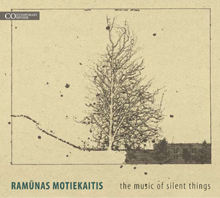The Lithuanian Music Information and Publishing Centre released a CD dedicated to the music by
Ramūnas Motiekaitis in November. The album includes five pieces by this young composer, his most conspicuous compositions for acoustic instruments. Moreover, the new release resumes the
Contemporary Composer series which has been launched to present the Lithuanian composers of today.
Describing his music, Motiekaitis uses words different from these employed by many other writers of academic music. He maintains an exclusive relationship with his creations which he has never applied as a tool to overwhelm listeners, to enslave them in an effective manner or have them inclined towards himself using the cheapest means of expression. Motiekaitis never concentrates on issues related merely to the composition techniques preferring to steer a conversation gently to poetic auras of his pieces, exalted inspirations, which very often come from nature, good poetry or simply from phenomena of the daily round, and to his strive of turning music into sounds which dissolve in the environment. By taking this stance, the composer seemingly repudiates the traditions of Western arts while identifying himself with the culture of the East which he has been exploring. (He will shortly defend his doctoral thesis, written in Japan, at the University of Helsinki.)
The new CD, compiled by the composer himself, is like his self-portrait painted mostly with pastel colours using the brushstrokes of impressionist sounds. Moreover, Motiekaitis’ music, which is “silent in its nature”, has been further stilled during the recording by moving microphones as far as possible from the instruments and thus lowering decibels. However, even this is not enough to bring the composer’s ideas to the maximum. This is why Motiekaitis presents a compulsory instruction describing the way his music should be listened – a volume control set at the medium or lower, definitely not at full blast, so that the music could reach a listener as if from a distance. As the composer puts it, “this music could be an acoustic background, an adornment or an element of decoration applied at a spot which is definitely not at the upfront.”
LMIPC info

